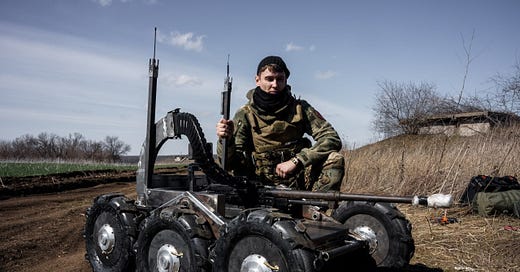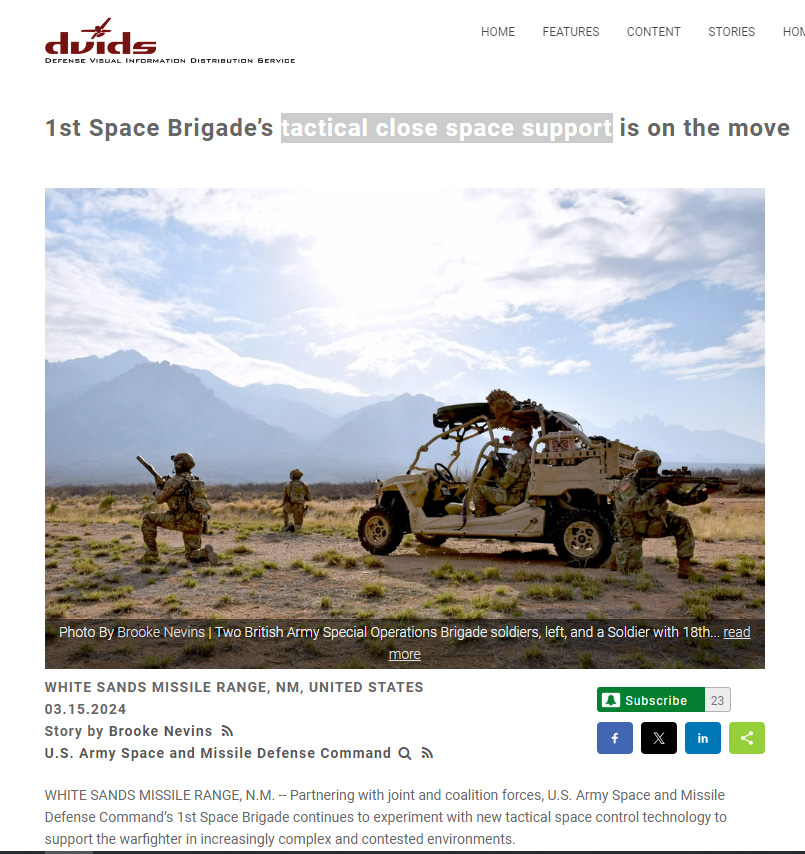This is technically part 3 of the Future of the SMO paid series I’ve been doing, with Part 1 here, and Part 2 here. However, I’m no longer going to number them as they are not a continuation, but rather independent articles on new topics which will operate under the same series name as that will be the designated paid subscriber only series. So if you’re not paid yet, don’t fear jumping in now as the current article is stand-alone and only loosely follows the general series theme of analyzing the SMO from a military-technological standpoint and extrapolating that onto future trends and developments.
This article is about 6700+ words and this time I’ve decided to leave free to the public, the first 2500+ of them, so a full nearly 40% of the article, so as to allow free subscribers to read at least up to the most important ‘bomb shell’ revelation. However, paid subs will see the new report further down of the first ever Russian mobile ground robot platoon taking part in real live hostilities, ushering in a devastating new age of warfare.
In the previous installment, we covered Russian military theorist General Baluyevsky’s think-tank paper Algorithms of Fire and Steel. This time we have another fascinating release from the official Russian military journal of the MOD, called АРМЕЙСКИЙ СБОРНИК, or ‘Army Digest’. It deals with assessing the opening state of the SMO and how it’s changed, with what adaptations the Russian MOD has been making to shore up weaknesses exposed in the course of the conflict.
What’s particularly eye-opening is how forthright it is in dealing with Russia’s limitations, particularly at the start of the SMO, allowing us a better understanding of the current state of things and how the war might evolve going forward.
Link.
It’s hosted on the official Russian mil site and apparently blocks Western addresses from accessing it, but you can still do so via VPN.
For the sake of authenticity, it is the March issue #3 of 2024, written by retired Colonel and veteran of military operations Oleg Falichev, and is called:
Exclude the Human Factor
It begins by recounting how Putin recently gave an assessment of the SMO at the end of 2023, and frankly asserted a few key problem areas where the Russian Armed Forces need work; namely: seriously restructure communication systems, increase the satellite ISR grouping, improve the work of air defense, increase the production and supply of high precision projectiles like Krasnopol and many others, etc.
“It is good that, two years later, we have finally begun to speak openly about the problems identified during the special operation. But what exactly did the Supreme Commander have in mind?”
The author first goes on to describe what the U.S. possesses in terms of a unified battlefield network-centric control system, which happens to be at the disposal of Ukraine. I want to paste the whole thing because it’s a very important consolidating primer on the subject, and makes for a sharp contrast with how he describes Russian capability afterwards:
So, over the past 30 years, several automated control systems (ACS) for ground forces combat operations have been created in the United States. All of them are integrated into a single contour, which provides real-time acquisition of processed situation data necessary for combat impact on the enemy by all, including promising, means of destruction.
The US global control system as a whole consists of: an
aviation contour, including unmanned reconnaissance vehicles, reconnaissance aircraft, including combat control and target designation aircraft of the AWACS type;
a space contour, consisting of optoelectronic reconnaissance spacecraft, as well as radar and radio-technical reconnaissance, and missile warning system satellites-secure
global space communications consisting of communication and relay satellites, weather satellites, and other spacecraft.The US wartime reconnaissance satellite constellation can consist of up to 500 spacecraft, of which up to 200 spacecraft can be located over the territory of Ukraine today. All this group works for the armed forces of Ukraine, transmitting data about our troops. It allows you to get high-resolution video and photo information that is sufficient to determine the number of our aircraft at airfields and the movement of large groups of troops. All the monitored situation is summarized and collected in the NATO Information Processing Center, from where the data is sent to the Armed Forces of Ukraine. This includes using the Starlink system, which is used for communication and fire control in the "company (battery) — battalion (division) — regiment"link.
Combining the means of reconnaissance and fire destruction of the enemy into a single system was called the network-centric concept of warfare in the general theory of war. It involves the creation of a single information space for control and fire destruction in the Theater of Operations area.
A note on that:
Firstly, here’s a recent diagram of total active satellites in space compared to Starlink, which is starting to single-handedly take over all earth’s orbit:
SpaceX Starlink satellites now make up almost 60% of the entire operational space constellation.
At this rate, Starlink will soon become the major dominant force in space.
On top of the above Russian assessment, a recent announcement revealed Elon Musk has signed a secret contract with the U.S. government to basically convert, as one report suggested, around 500 Starlink satellites into military versions with special cryptographic properties:

Unfortunately for Russia, this puts the U.S. and its allies—like Ukraine—several years, and potentially a decade or two, ahead of Russian capabilities in this area. As Colonel Falichev indicates in the next part, this is one area where Russia has severely lagged since the fall of the Soviet Union, simply ignoring the problem as its ramifications were never quite palpably felt by the aging military upper crust.
They are now rushing out a Starlink analog, but a basic operable fleet won’t be ready until at least 2027-2030. In order to even the odds in the meantime, Russia has reportedly been smuggling in a large amount of bootleg Starlinks, which they claim to use at the front despite Musk’s protests that Starlink service does not operate “over Russia”. Of course, the battlefield contact line is quite a hazy ‘gray zone’ and likely allows Russian forces to get service.
Though as a quick aside, Russia’s communications issues aren’t ever as bad as claimed. Just yesterday a Ukrainian comms expert angrily reported the increasingly widespread use of a new Russian “Wave Network” of radios, which he described as follows:
The Wave Network packet communication solution is based on MESH technology. Within the framework of this technology, each walkie-talkie is not just a walkie-talkie, but also a repeater. That is, all signals scatter to all the nearest neighboring stations and there are no limits to this. This is very useful for the military. For example, when a convoy of equipment stretches for 10 kilometers travels, all radios transmit information along the chain. Or all the soldiers along the front communicate without repeaters.
Not to mention it is AES128 encrypted.
But while Russia scrambles to catch up to U.S. communications capabilities, the U.S. is attempting to leap even further into the future with the announcement of the world’s first ever space-based tactical close “air” support:
The above article summarizes it as follows:
“Larger space capabilities cannot effectively integrate with more expeditionary units, such as SOF (Special Operations Forces),” said Capt. Noah Siegel, Triad Experimentation Team platoon leader, 18th Space Company. “Shrinking our equipment and focusing on mobility allows our Soldiers to provide space support to units of all types at or beyond the tactical edge. For warfighters on the ground, this tactical space support enables the synchronization and convergence of joint and multidomain effects to enhance lethality.”
In short, it’s the ability to have a smaller imprint mobile satellite liaison unit that can give network-centric and signals data to frontline units on the fly without the traditional worries of communication links disruptions due to jamming or distance from unit HQs, or having to setup bulky stationary satellite relays. I.e. space support at the tactical level. It may sound simple, but it’s something that nations without massive satellite infrastructure would struggle to do.
But the above was just a test run with a small unit, and is in no way being rolled out en masse in the U.S. Army any time soon, as the article itself admits.
Getting back, Colonel Falichev asks: What do we have by comparison?
What do we have?
Looking ahead, I will say that we are quite successfully fighting the enemy's intelligence system using various electronic warfare tools. But for a long time we were not able to bring our effective fire control system, as they say, to mind. It is enough to recall the similar Constellation system created since the times of the USSR, which left much to be desired. Only recently have they developed and launched a series of their own automated artillery fire control system, in particular, "Tablet-A" (Planshet-A system). And the special operation in Ukraine has accelerated this process.
JSC "Russian Corporation of Rocket and Space Instrumentation and Information Systems" ("Russian Space Systems") has developed the first domestic analog of the Starlink system. For this purpose, the Sphere communications satellite was launched into orbit. The system is already being tested in the military. Let us explain that JSC Russian Space Systems specializes in the development, manufacture and operation of space information systems, in particular, in the development and targeted use of the global navigation satellite system GLONASS, the space search and rescue system, hydrometeorological and radio engineering support for scientific research in outer space, and remote sensing of the Earth. Today, the development of such technologies in Russia has been given the closest attention, which was required by the experience of conducting free economic education.
In addition, the President of the Russian Federation has considered the Concept of Technological Development of Russia until 2030. Among its sections are promising space systems and services.
The Planshet-A system is one I’ve been reporting on for a long time, which is a battlefield management system Russia has slowly been rolling out since the start of the conflict. One recent example of a new analogous Russian system on the front was just posted this week—though I believe this is a more DIY ad hoc one. You can see the realtime geolocation of ongoing tactical fights, with the information and coordinates able to be transmitted to other relevant units:
Exclusive . We finally have the latest program for command and control.
Designed for interaction, coordination, control between different departments. An analogue of the Ukrainian "Nettle", its extended version.
I would like to draw your attention: “Nettle” was with the Ukrainian Armed Forces until the age of 2022. That is, they were preparing for a certain type of war, unlike us. They knew that they would attack and they knew with what type of weapons.
From a reliable source.
Incidentally a new video of another such Ukrainian system has also come to light, showing the Ukrainians are arguably still a step ahead in implementation:
Pay attention to how they can insert tactical symbols onto a map, which gets instantly distributed to all units operating one of these networked tablets.
Falichev goes on to underline what I already prefaced above—why Russia began to lag after the fall of the USSR, including the infamously resented Serdyukov reforms of 2008, of which I also previously wrote a lot on:
LESSONS AND CONCLUSIONS
Of course, the question arises: why did this happen? After the collapse of the USSR, we paid very little attention to this segment of our defense, as, indeed, to the development of the Armed Forces of the Russian Federation as a whole. Recall that in 2010, the Armed Forces underwent major structural changes. Motorized rifle and tank divisions were transformed into brigades. According to Colonel-General, Doctor of Military Sciences, corresponding member of the Russian Academy of Rocket and Artillery Sciences Vladimir Zaritsky, the army and front-line sets of Rocket troops and artillery were abolished. Thus, we lost about half of the firepower of artillery units and formations, and almost half of the firepower of Ground Forces.
But he says Gerasimov and Shoigu’s arrival has ushered in a restoration of all previously lost power:
But with the arrival of the new leadership of the Ministry of Defense, Defense Minister Sergei Shoigu, Chief of the General Staff Valery Gerasimov, the restoration of the system that was practically lost, in particular, the divisional structure, and in the Missile Forces and artillery of the Ground Forces — the restoration of combat power.
He states that in particular, special attention was paid to such electronic intelligence systems, which further ushered in the development of new much-needed battlefield recon and counter-battery systems like the ‘Arkus’ and ‘Penicillin.’
But here’s where he makes the biggest bombshell of the report, which is truly a world exclusive in divulging this information for the first time ever:
With the beginning of the SVO, we had only about 10 Zoo-1M complexes in the army. This led to the fact that at first we lost the confrontation in the counter-battery fight. The lack of necessary specialists also affected the situation.
We’ve heard complaints from the front for a long time that Russia needed more counter-battery capability. There were speculations of all kinds as to numbers, but no one knew precise amounts. Here for the first time he reveals that the entire Russian army had a miniscule 10 Zoopark counterbattery units at the start of the SMO.
Granted, in the very beginning, artillery counterfights had not yet gained the type of significance they have now, as the conflict had more a mobile expeditionary-style character than the static classical artillery war we see today. Russia did begin increasing production of everything right away—but it’s still extremely telling how little of the workhorse counterbattery units they had at the onset.
Keep in mind, there are other types of counterbattery—so Zoopark isn’t the sole one relied on. Not only were there the mentioned Penicillins—though potentially even less of those prestige systems—but also things like the Yastreb-AV, Snar-10, and many other smaller portable tactical units like the Aistyonok, Sobolyatnik, and even the Fara-PV. So while the situation wasn’t quite as dire as it sounds, it was far from ideal.
Now, however, things have changed. Just last month Shoigu visited the NPO Splav and NPO Strela enterprises, where he was shown a full production line of the latest Zoopark-1Ms under construction:
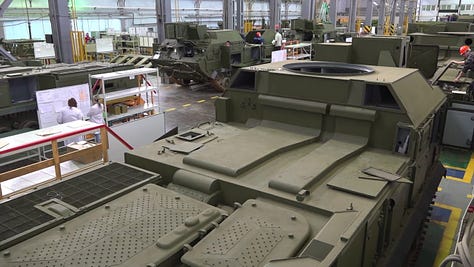
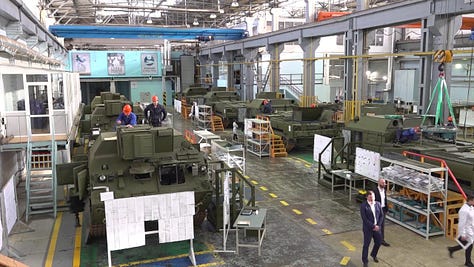
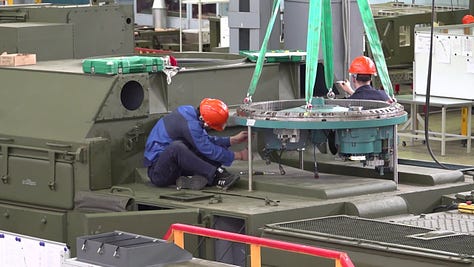
One can see the workshop could have as many as a dozen simultaneous systems being built. So while we don’t know the exact production number, here’s what NPO Strela stated:
NPO Strela claims it fully completed its 2023 obligations for delivery of Yastreb-AV, Zoopark-1M (pictured), and Aistyonok counter-batter radar systems and will increase production by 2x in 2024 and 4x in 2025 thanks to new equipment and the transition to a 12-hour-shift, 6-days-per-week schedule.
So, Zooparks have already increased production, but will increase 2x in 2024, and 4x in 2025. Meanwhile, even Oryx’s list only lists 16 total ‘proven’ Zooparks destroyed. That means if Russia is even building 50-100 of them per year—which is possible given the near dozen simultaneously constructed in the workshop—it vastly over-compensates for any losses.
Keep reading with a 7-day free trial
Subscribe to Simplicius's Garden of Knowledge to keep reading this post and get 7 days of free access to the full post archives.


